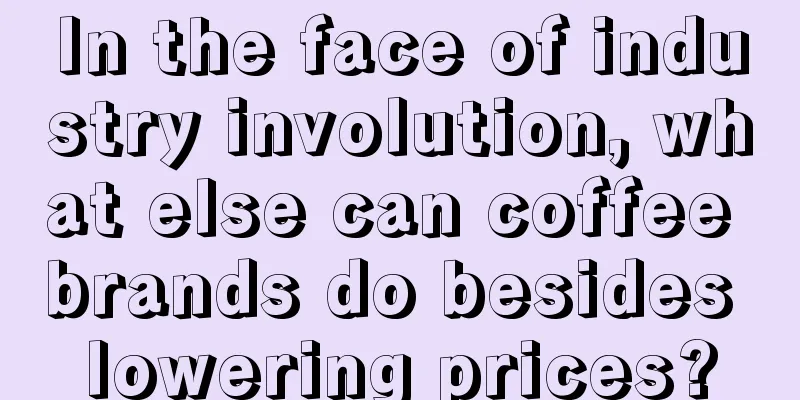A Guide to Avoiding Pitfalls in Brand Upgrading

Those who have experienced a brand upgrade often find that after the upgrade, they still feel like something is wrong, but they can’t explain it. Sometimes it’s like a doctor injecting them with a quick-acting heart-saving pill that only works for a while. We spend half of our time every year upgrading different brands. We have experiences of 3 years, 10 years, and even 100 years. There have been good and bad experiences, as well as some small lessons learned. We hope that we can help brands that are planning to upgrade or are in the process of upgrading. The entire article is arranged in order: before the upgrade, during the upgrade, and after the upgrade, and each stage corresponds to different issues. Before upgrading, brands need to have a clear understanding of the overall upgrade and psychological expectations. Of course, the most important thing is that you need to figure out why you want to upgrade. 1. Before Upgrading1. Why upgrade?“My brand is too old-fashioned, can you help me create a new VI?” I think this is the most common request that most design companies receive and hear. If we continue asking.
If these issues have been sorted out and thought through very clearly, that is a good thing and they do require design. But the reality is often that when a brand thinks there is a problem with the visuals, it may be that something higher-level is not clear. Should the positioning be adjusted? What is the strategy? What is the future strategic direction? Some issues concerning the brand concept have not been resolved. However, because vision is more obvious, it is easy to think that there is something wrong with vision. Therefore, when upgrading a brand, one must first clarify why the upgrade is required and what problems need to be solved so that the right remedy can be found. The problems that need to be solved when upgrading old brands are often complex and diverse. It may involve almost all aspects: users, strategies, design, products, space, display, channels, marketing, production, etc., all need to be adjusted. From the perspective of saving trouble, everyone wants to find a company to solve all problems. But from my work experience, it is rare for a company to solve all problems in one go. The closer we get to the end of the project, the more we can feel it. For example, when a brand upgrades the display in a flagship store, people often think that space design can solve the problem, but in fact this is a specialty of display design. Correspondingly, the display designer will bring her professional suppliers. Upgrading is a comprehensive task that requires cooperation from multiple teams. Don’t try to save trouble by only finding one company to solve the problem. 2. Paralysis of upgradesIn the atmosphere of various official announcements of upgrades, we often expect to solve all problems at once through an upgrade, embrace new users and markets, and achieve all-round brand renewal. The idea is correct, but it is easy to produce overly high expectations and unrealistic fantasies. Especially in the later stages of implementation, it is easy to have unbalanced psychological expectations, only seeing those problems that have not been completely solved, while ignoring some effective results and the original core demands. Therefore, before planning to upgrade, you must be aware of the "paralysis" of the upgrade under the bombardment of various media platforms. Paralysis 1: Brand upgrading is not necessarily successful. Not all brands can upgrade like Holiland and Li Ning, which have both voice and sales. Even they took several years to truly upgrade successfully. It is possible that right after the upgrade, the overall performance of the brand is worse than before the upgrade. After so many years of accumulation, it is not easy to adjust the perception of users and the market all at once, especially when the changes are relatively large, the user groups may also change. Everyone hopes to gain benefits through upgrading, but benefits are often accompanied by risks. Objectively speaking, if the upgrade solves the core problems of the initial setup, then it has been successful at this stage. Therefore, be rational in your expectations, don’t have too high expectations, and don’t try to solve all problems at once. The second paralysis: Even a successful upgrade will not produce immediate results. Everyone likes the highlight moment when a brand upgrade is launched, gaining appreciation from competitors, praise from users and even an overall increase in revenue. But the real effect of the upgrade cannot be judged at the moment of its debut. Have you really upgraded? This is very similar to the difference between Western medicine and Chinese medicine. Some upgrades only treat the symptoms and have quick effects, but lack stamina. For example, in recent years, many brands have changed their "clothes" in order to cater to young people and market trends, which may not necessarily be in line with the brand's core values and long-term strategic direction. It may work now and help the brand get through its current difficulties, but it may not accumulate lasting assets for the brand. Some upgrades treat the root cause and adjust things at the root. They may not be effective so quickly. It may take some time before we look back and find that the upgrade was indeed the right one. For example, some upgrades are designed to discover and establish core values and cultural content that are unique to the company. This requires the team to nurture it over a long period of time, allowing the tree to grow slowly and bear fruit. For this type of team, upgrading is about planting the “seed” and the team spends time cultivating it. 3. AnchoringFaced with uncertain environmental factors, we will think about taking one step at a time and starting over. But brand upgrading cannot. It requires a rough overall investment before starting. How much time, money, and effort you initially want to invest in this upgrade will determine how it ends up looking. You may say that there are many variables in the middle? Precisely because there may be variables, we need to have the concept of overall investment. You need to know roughly how much to invest in different parts of the upgrade so that you can make an overall allocation when variables come, instead of arbitrarily adjusting the investment without considering the overall situation when there is a slight change. Generally speaking, the approximate actions and costs are these. However, many teams may have no idea about investment, especially old brands, which are unfamiliar with the young market and find it difficult to grasp. At this time, it is very important to anchor a benchmark in the early stage, which can enable both external and internal teams to quickly have a more concrete perception. But anchoring and benchmarking is not as simple as calling out one or two brand names. The core of anchoring benchmarking is to know yourself and your enemy. What does it do in a cycle? To what extent did it achieve this? What results did it lead to? What kind of team did it use to do these things? How much time and money does it cost to do these things? It can be as small as a package or a campaign, or as big as an offline experience store. Only when you have a rough understanding of these can you know how far you are from it at present. Take a fragrance brand as an example, suppose your anchor is Guanxia. At least you need to stop in Guanxia’s store several times to feel the relationship between its brand and users, its experience links, service language and product shaping, etc. Feel first, then analyze. It is also important to understand what is the core driving force of anchoring benchmarks? Is it content, channels or products? If it is content, what is Guanxia's team structure in this regard? What is the general investment in content each time? How is the path and logic of new product development different from yours? What is the location logic and rent of Guanxia's offline stores? Even more, if you also have some resources of its products, packaging materials, and content production suppliers, I believe you will be more confident in the allocation of investment for this upgrade. It is best if these things are your own first-hand information, without relying on others. Perhaps the partner who provides you with brand upgrades will understand this, but the degree of impression brought by this is much weaker than the reality brought by your own first-line experience. In fact, when many brands are first established, they do all these things in detail, and even "lurk" into the benchmark objects. But when upgrading, these preparations are easy to be neglected. The above will give you a psychological expectation of the difficulty and time of upgrading, so that you will not be at a loss when encountering difficulties. 4. Overall R&DWe often make it clear in the initial communication meeting with the upgrade project client that brand upgrade is an overall research and development. It is not just the research and development of the product. Strictly speaking, the entire brand model after the upgrade, whether it is a small upgrade or a major adjustment, can be considered a research and development. New concepts, products, packaging, language, supply chain, etc. are all part of brand upgrading and research and development. Since it is research and development, there will be difficulties. The first and foremost difficulty is the internal iteration difficulty. Three years ago, the founder of a sushi brand communicated with us. At that time, his brand had hundreds of stores across the country. Before coming, he believed that the brand needed an upgrade to adapt to current users. After we finished talking, he said: "Shaokang, if we upgrade the brand, my internal team may not be able to handle it, and it will be difficult to operate it later. Even if the upgrade is done well, it will not belong to us." Looking back, the founder was clear-headed. He said the team couldn't handle it. What exactly does that mean? This situation mainly occurs during and after the upgrade process. Let’s talk about it first. 2. Upgrading1. Immediate differenceGoals and plans will determine the presentation standards we need to achieve. In particular, the upgrade and solution goals are as follows: “Comprehensively improve brand quality and experience” “Explore and reshape the core value of the brand” “Establish a brand content system” “Visual and packaging upgrade” For users, this is actually no less than the launch of a new brand, and there needs to be an immediate difference. Although brand upgrading does not mean starting over again, for most upgrades, it is not enough to be just slightly better than before. You see, often only upgrades from big brands will look like no upgrades... because they were already very good. Users who are familiar with you look forward to your changes and even need surprises beyond their expectations. The new users you want to attract don’t know who you are yet. There is often only one chance for a new brand to debut, and sometimes there is only one chance for a brand upgrade to debut. But past experience tells us that this presentation standard will be constantly compromised during the implementation process, due to both internal and external reasons. 2. Implementing the plan and encountering difficultiesAn upgrade plan often requires the cooperation of multiple teams to complete, but we often encounter the following situations. (1) Products The product needs to be upgraded, but the product development ideas are still stuck in the past, or there is a shortage of R&D personnel, resulting in slow progress, and the product is rushed to go online in the early stage of implementation. Finally, other aspects of the upgrade are in place, but the product reputation has been declining, the negative review rate has soared, and users think it is just for show. The team began to doubt the significance of the upgrade and morale was low. (2) Packaging The quality and experience of packaging needed to be improved, but the team had different understandings of "quality" and lacked concept of packaging costs, so they continued to choose the low-priced suppliers they had previously cooperated with. In the end, the workmanship did not meet the standards. Faced with new requirements, the overall texture and details were never satisfactory, and there was even a large amount of scrap and loss. (3) Time Research, planning, design, packaging, and products all took a long time, and there was no time left for the final mass production. We had to rush to launch the product online, which resulted in various problems. (4) Stores When upgrading a store, the space designer required the quality of a flagship store, but the brand’s long-term construction partner was accustomed to standard output and could not meet the implementation standards. (5) Consultation The consulting company fails to fully grasp the brand's strength and endowment, and the solutions it provides only satisfy the founder's preferences, or only satisfy the preferences of "young people", and are divorced from the brand's strengths and weaknesses. The later team is unable to implement and apply the solutions, and internal conflicts arise. This involves many issues such as internal team iteration, long-term supplier relationships, and external service providers. This is exactly what the founder of the sushi brand was worried about. Some problems do require trial and error, and the cost and price of upgrading. But most of the problems can be solved and avoided. First of all, anchoring benchmarking before upgrading can allow multiple teams to have as unified presentation requirements as possible, and will also allow brands and founders to have a concept of time and cost that is close to reality. To avoid the upgrade in progress, the plan is gradually "castrated". Second, the selected service provider team usually comes with matching suppliers. Since upgrading is a research and development, why not try to be open-minded and accept new partners? Third, upgrading is not just about upgrading the “external part of the brand”; upgrading the internal team is equally important. One is that during the process, the internal team can begin to accept information from the external team, allowing partners to fully unify the core logic of the upgrade so that it can be reasonably used in daily operations after the upgrade. Another thing is that there are some new requirements that the original team really cannot meet. In that case, in the middle of the upgrade, we should consider recruiting some suitable talents as new blood to connect the past and the future. Finally, the founder’s overall coordination is crucial, and I believe I don’t need to say more about this. 3. Start to benefitYou will actually find out after reading this. When the upgrade direction is correct after countless discussions, the brand has actually begun to benefit. Including but not limited to: clear strategy, clear thinking, breaking away from internal competition, team iteration, supplier update... 3. After Upgrading1. From implementation to daily lifeIt’s a common saying: The moment the brand upgrade is implemented is not the end, but the beginning. If the brand before the upgrade is called 1.0, then the moment the upgrade is implemented means that all your brand operation work has leapt to 2.0, and 2.0 will become a daily routine. 2. Knowing how to use it is the keyAfter a successful brand upgrade, can the team really digest the logic of the upgrade and apply it in subsequent work? We often see two situations. One is not knowing how to use it. Maybe after half a year, the brand’s core content, vision, and products will still remain the same as they were before the upgrade, with little change. The other is to use deviation. This often happens in the visual design part. Sometimes, even if the VI manual is delivered, it will be difficult to continue if the designer does not understand the logic behind it or is not up to the standard. These two problems can be solved either through internal or external training, or by seeing whether the team's blood is renewed during the upgrade. 3. Continuous iterationThe moment an upgrade is implemented, problems will inevitably arise. Just like every major version update of IOS, there will basically be a small update within 2 weeks to fix these bugs. Therefore, no matter how carefully the multi-party teams consider everything, there will inevitably be omissions, which may affect morale or even business, but please don’t worry, just optimize and iterate one point at a time. The reason why some consulting companies charge annual service fees is that after each project is implemented, continuous optimization is required to achieve the ultimate goal. Upgrading is a research and development process, and research and development requires continuous iteration. Perhaps such iterations need to continue from 2.1 to 3.0, but as long as it is moving in a good direction and can provide users with better value, it is worth it. All the successful implementations and continued successful subsequent operations that you have seen have also gone through countless iterations of varying sizes internally. Author: Shaokang loves brain burning Source: Shaokang Blake (ID: shaokang92) |
<<: On TikTok, has the "Northeastern Father-in-law in the South" series become the secret to a hit?
>>: 2023 Marketing Predictions | CMOs will incorporate customer relationship health into new metrics
Recommend
How to quickly increase Amazon store traffic? What are the tips?
Traffic, weight and sales are very important when ...
How does Pinduoduo test images, models and links?
Master the skills of testing images, models and li...
Young people have a double standard for pre-prepared meals: they can buy them on their own initiative and refuse to be “fed” by restaurants
Pre-prepared meals have always been a topic of soc...
Xiaohongshu poetry copywriting, the new favorite of brands
We yearn for poetry and distant places, but someti...
Are there risks with Amazon Linked Accounts? What are the risks?
When you are using Amazon, you can check the accou...
What should I do if I am cheated by a cross-border e-commerce company with no source of goods? How to solve it?
Now everyone knows that cross-border e-commerce ca...
Discussion | How can the public relations department find a sense of presence?
Most small and medium-sized enterprises do not act...
WeChat Stores releases a series of big moves
"New developments in WeChat Stores, e-commerc...
This is how the local dating group with a monthly income of 100,000 yuan generates traffic
In the fast-paced era, long-term stable relationsh...
Which one is better, Wish or Shopee? What is the difference?
There are many cross-border e-commerce platforms n...
7 core questions about Xiaohongshu’s community, growth, and people-oriented approach
This article takes the growth of Xiaohongshu as th...
Label your brand and break the dilemma of homogeneity!
The pace of the times is accelerating, and brand o...
How much is Amazon's overage inventory fee? What is the calculation logic?
Merchants who open stores on Amazon should be fami...
How can small and medium-sized consumer brands catch up with the new offline hot battlefield?
This article delves into how small and medium-size...
Draw your "ideal customer" in 3 steps: a guide for efficient customer acquisition for B2B companies
In the growth process of B2B enterprises, accurate...









